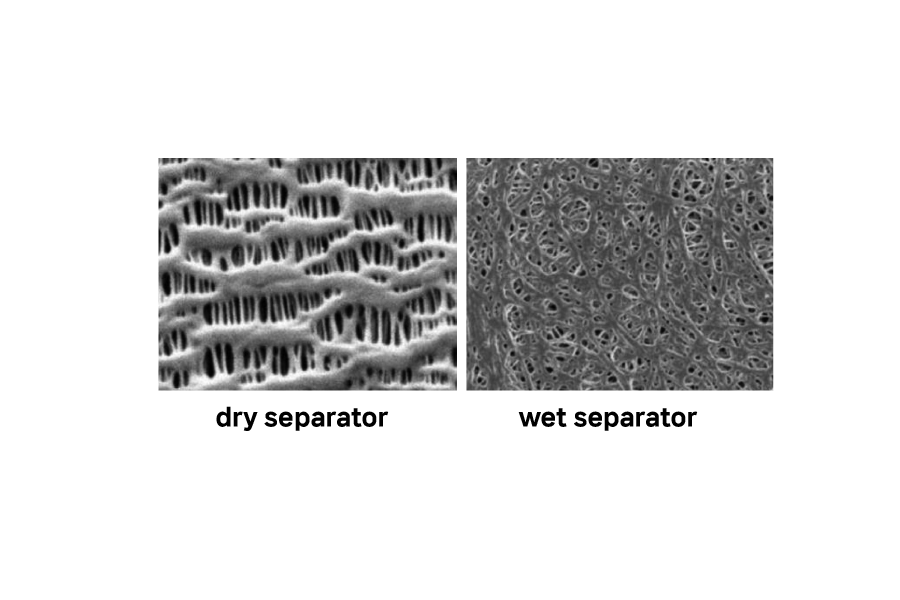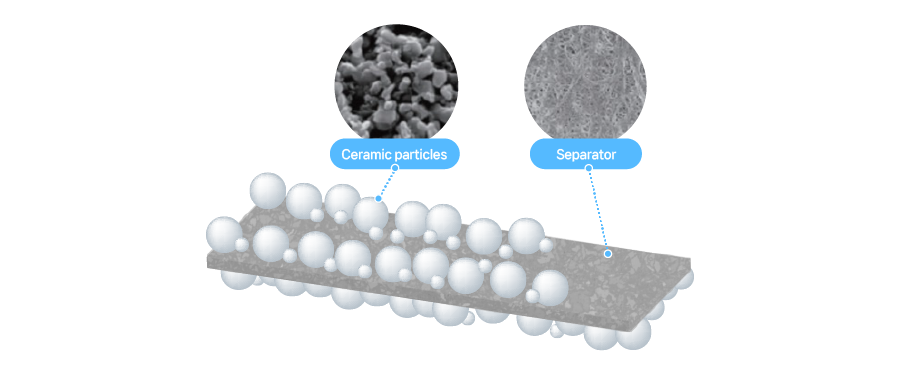Technology & Products
[Battery101] Seperator Keeps Cathode and Anode Apart for Safety
2024.07.12
|
101[wʌ́nouwʌ́n] means basic knowledge of a topic or collection of introductory materials to a topic. Our Battery 101 series talks about all things battery: the history, technical aspects (basic principles and mechanisms), industrial aspects (IT, electric vehicles, ESS, etc.), and next-generation technologies that SAMSUNG SDI will innovate while opening up its future. Batteries have infinite potentials that exceeds our wildest imagination. Through Batteries 101 series, you will have a chance to see the entire spectrum of the battery's possibilities and to conjure SAMSUNG SDI’s pivotal role in it. |
Safety is the top priority of separator
Separators mainly play three roles. First, a separator is a physical barrier that keeps the cathode and anode apart. When an abnormal condition causes the inside of a battery to heat up, it may lead to in a short circuit between the cathode and anode as the liquid electrolyte dries out, resulting in a fire or explosion. The separator acts as an insulating layer that prevents such events from taking place.
Second, on the separator surface, there are the pores that are invisible to the naked eye. Lithium-ion batteries are charged and discharged repeatedly by moving lithium ions back and forth between the cathode and anode through this passage.
Third, the separator ensures safety. They block the movement of lithium ions as the pores on the separator surface are closed when the temperature inside a battery rises above a certain level. Like vinyl shrinking from heat, those holes are closed to avoid short circuits when the battery gets hot. Furthermore, the separator has a high mechanical strength to block the movement of foreign substances or byproducts generated from inside a battery upon impact. This mechanism is also a very critical factor to ensure battery safety.
Separators in lithium-ion batteries are very thin, between 5 μm and 30 μm, with pore sizes at about 10 μm to 500 μm. The separator itself is irrelevant to battery capacity. However, it can help increase the energy density as thinner separators mean that you can put more cathode/anode active materials in the given space. That's why a lot of studies on the battery separator are focused on reducing its thickness while battery manufacturers nowadays are trying to develop thinner separators with higher mechanical strengths.
Differentiating with the outstanding separator coating technology
There are two categories when it comes to ways of making separators: a dry method and a wet method depending on how a separator’s pores, where lithium ions travel, are made.

[Microscope images of wet separator (left) and dry separator (right)]
The dry method is a relatively simple process that involves stretching film materials to open up the interface of polypropylene (PP) or polyethylene (PE) crystals and make pores. In the wet method, oil and other additives are added to PE and mixed at high temperatures and pressures to extract films. The phase separation of PE and oil takes place during cooling and molding. Here, pores are created on the areas where oil is extracted by using a solvent.
Both methods have their pros and cons. For instance, making dry separators is simple but they come with pores of varying sizes and weaker mechanical strengths than the ones produced with the wet process. On the other hand, wet separators makes the uniform-sized pores but go through a complicated manufacturing process, which means they cost more.
Long ago, separators used to be made with only one ingredient—a base fabric film material. These days, however, battery makers implement a wider range of materials and coating techniques to enhance the performance of separators. The adoption of coating technology has been pivotal in increasing the safety of battery separators.
Coating technology is divided into heat-resistant coating and adhesive coating. Heat-resistant coating involves coating heat-resistant binders and ceramic particles on the separator film to suppress the shrinkage. In adhesive coating, on the other hand, adhesive binders are coated on the separator film, which is then bonded with an electrode to enhance safety and avoid deformation.

[Surface images of ceramic-coated separator]
SAMSUNG SDI’s separators are manufactured by coating polymers and ceramic slurry on externally-sourced films and boast excellent heat resistance and adhesiveness along with remarkable cost competitiveness. Our research and development began in 2013, and we completed a separator production line at our Gumi site in the following year, which enabled SAMSUNG SDI to secure differentiated competitiveness in this field.
SAMSUNG SDI has also developed an ultra-high heat-resistant and adhesive separator with multi-layer coated separator (MCS) technology where ceramics and binders are coated concurrently on the surface of a battery separator. This technique serves to increase heat resistance, lowering the risk of battery fires and raising the safety against physical impact.
